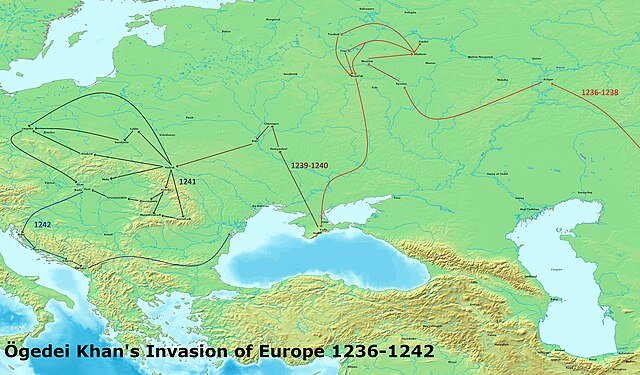When we discuss the Mongols and their invasion in the 1230s — 1240s, their actions in Russia are in the center of attention for obvious reasons. But we should not forget that the western campaign was by no means limited to Russia. Steppe tumens have passed Hungary and Poland. A part of the Mongolian army has left to coast of Adriatic, a part has reached Northern Italy, and still a part has managed to skid on territory of Germany.
When we say Germany, we mean, of course, not a single state, but a set of German principalities, which recognized the general power of the Emperor. We have to make such a reservation, because in the comments there will definitely be a character who will start writing that Germany appeared only in the XIX century.
So, let’s return to the Mongols. How far to the west did they get? At what point did their campaign end?
To begin with, let’s briefly retell the course of events.
In January 1241 the grouping of Mongolian troops crossed the border of Poland. It was led by the Chinggisids Kadan, Baidar and Ordu-Ichen (the latter, by the way, was Batyi’s older brother). As usual, they acted quickly and boldly. The operation began in winter, for which the Poles were not ready.
Lublin and Zawihost were captured on the move, and on February 13 the battle of Toursk took place. The favorite tactics of the Mongols with a feigned retreat and a sudden counterattack gave its result — the Poles were defeated. On the same day fell and Sandomir.
Prince Henry the Pious, who ruled Poland at that time, tried to gather all the troops he could. He negotiated with the Teutonic Order, which sent him knights. He negotiated with the French Templars, who also sent a detachment. He agreed with the Czech King Wenceslaus — and the Czech army rushed to his aid.
In April 1241 the battle of Legnica took place, during which the Mongols completely defeated the united Polish-German army. The Czechs had no time to get to the battle site, being only one day late. Henry the Pious fell in battle.
Having rested for two weeks, the Mongols moved on and reached the German city of Meissen. To give you a rough idea of the map, that’s northwest of Dresden. Although… Let us show you on a modern map where it is:

In general, the Mongols were already well settled in Saxony, drinking horses in the Elbe (Meissen stands on the bank of this river). But then Baidar received an order to urgently go to join the main army. Yes, the detachments of Baidar and Ordu-Ichen were only auxiliary. The main forces of the Mongols acted to the south, crushing the Hungarians.
From Meissen, the Mongols moved south, terrorizing Czech Moravia, and then passed Vienna — eight miles from the Austrian capital. They did not get into a fight with the united Czech-Austrian army covering Vienna, because they had to hurry to Batyi, who was besieging the Hungarian fortresses.
The Hungarian campaign, the breakthrough to the Adriatic and the burning of Zagreb is a separate story. And here we are talking about the westernmost point of the Mongol advance. So, the German town of Meissen is the westernmost point.
